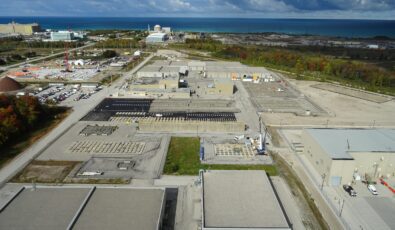OPG enters partnership to supply important medical isotope faced with global shortage
At a glance
- OPG’s nuclear power reactors are a critical source of important and life-saving medical isotopes for the world.
- The company is now launching a pilot project to supply another isotope, Carbon-14, which is important in drug development.
- For decades, Russia was the only source of Carbon-14. OPG’s Carbon-14 will offer the life science industry an alternative supply to meet shortages caused by the Russo-Ukrainian conflict.
For more than half a century, OPG’s CANDU nuclear power reactors have provided Ontario with low-carbon, reliable, and safe electricity to power our homes, businesses, and lives.

At the same time, these workhorses have also supplied important medical isotopes to ensure millions in Canada and around the world can enjoy a healthier and safer quality of life.
From sterilizing medical equipment and food to diagnosing cancer and heart disease, Ontario’s nuclear products continue to benefit society in a myriad of ways.
And the future looks even brighter as OPG keeps innovating to deliver more important isotopes for the world.
Today, OPG’s Nuclear Medicine and Isotopes team is working to fill a worldwide supply shortage of the major medical isotope Carbon-14, in partnership with CCNuclear and RC-14.
Our partnership will support the development of cutting-edge life science research. In the end, this project will reduce waste, help protect the environment, and produce a valuable isotope to help meet global demand.Kapil AggarwalVice-President of Nuclear Sustainability Services at OPG
This radioactive isotope, which is produced in OPG’s nuclear power reactors during regular operation, is used predominantly as a biotracer to understand chemical and biological system pathways. It plays an important role in the life science industry as it’s used in the development and certification of new drugs, cosmetics, and in agrochemical industries.

Since 2022, the world has been faced with supply shortages of purified Carbon-14 due to the Russo-Ukrainian conflict, as the isotope has historically been produced in Russia.
OPG is now working to fill that shortage, in partnership with nuclear service provider, CCNuclear, and its isotope producer subsidiary, RC-14. The effort is starting with the launch of a pilot project aimed at repurposing OPG’s reserves of Carbon-14, which is an intermediate-level waste product currently stored at OPG’s Nuclear Sustainability Services’ (NSS) Western facility in Bruce County.
New innovative systems developed by CCNuclear and RC-14 will help harvest and concentrate OPG’s Carbon-14 to make it available for the life science industry. This will ultimately help fill a major need for the world while benefiting the environment by reducing the amount of Carbon-14 stored at the site.
“Our partnership will support the development of cutting-edge life science research,” said Kapil Aggarwal, Vice-President of Nuclear Sustainability Services at OPG. “In the end, this project will reduce waste, help protect the environment, and produce a valuable isotope to help meet global demand.”

“This innovative approach for harvesting OPG’s Carbon-14 is set to provide the life science industry with an alternative source of Carbon-14,” stated Stéphane Leduc, CEO of CCNuclear and RC-14. “Following the pilot, this initiative has the potential to secure a long-term, reliable supply for the industry, which could significantly enhance and expedite drug development.”
Did you know? Carbon-14 is just one of many beneficial isotopes generated by OPG’s nuclear power operations. The company’s reactors are also a critical source of Cobalt-60, Molybdenum-99, and Yttrium-90. These medical isotopes are used to sterilize single-use medical devices, detect illnesses like heart disease, and treat cancer.
In addition to Carbon-14, OPG and its subsidiary, Laurentis Energy Partners, are giving other nuclear by-products new life, including Tritium and Helium-3. These isotopes are used in emergency lighting, quantum computing, medical research, border security, and in the development of nuclear fusion.
Learn more about nuclear isotopes.
Learn more about nuclear service provider CCNuclear.
Learn more about isotope producer RC-14.
Subscribe and stay informed
Sign up to receive the latest news, project updates, and event information from OPG.


